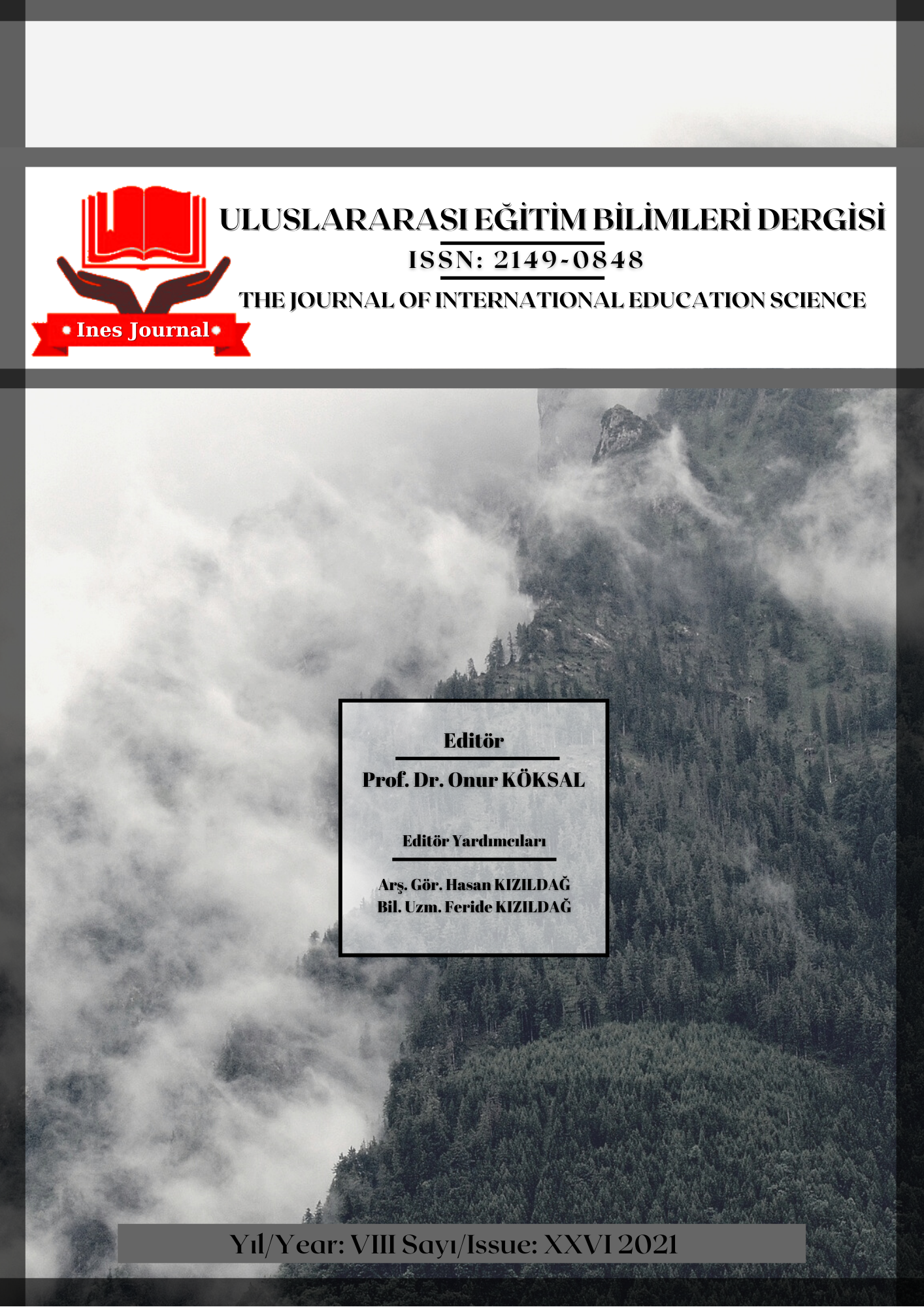Author :
Abstract
Bu araştırma, okul öncesi eğitim kurumlarına devam eden farklı bilişsel tempoya sahip 60-72 ay çocukların görsel algılarının incelenmesi amacı ile yapılmıştır. Çalışma grubunu 2018-2019 eğitim-öğretim yılı Konya il merkezinde, MEB’e bağlı bağımsız anaokulları ve anasınıflarında eğitim alan 726 çocuk oluşturmaktadır. Araştırmada ilişkisel tarama modeli kullanılmıştır. Veri toplama aracı olarak Wright (1971) Kansas Okul Öncesi Dönemdeki Çocuklar İçin Düşünsellik-İçtepisellik Ölçeği A Formu ( Kansas Reflection–Impulsivity Scale for Preschoolers Form A – KRISP ) ve Frostig Görsel Algı Testi ( Frostig Developmental Test of Visual Perception ) kullanılmıştır. Araştırmada ulaşılan genel sonuç; Bilişsel Temponun, Frostig Görsel Algı Testi Toplam puan ortalamaları ve Göz-motor koordinasyonu, Şekil-Zemin Algılanması, Mekânsal İlişkilerin Algılanması alt testlerine ait puan ortalamaları üzerinde bir etkiye sahip olmadığı tespit edilmiştir. Fakat Frostig Görsel Algı Testi’nin Şekil Sabitliğinin Algılanması ve Mekânda Konumun Algılanması alt testlerine ait puan ortalamalarının çocukların bilişsel tempolarına göre anlamlı düzeyde farklılaştığı tespit edilmiştir. Bu farklılaşma reflektif çocukların lehinedir.
Keywords
Abstract
This research was carried out to examine the visual perception of 60-72 month-old children with different cognitive styles attending preschool education institutions. The study group consists of 726 children studying in independent kindergartens and kindergartens affiliated to the Ministry of National Education in the city center of Konya in the 2018-2019 academic year. Relational scanning model was used in the research. Wright (1971) Kansas Mindfulness-Impulsivity Scale Form A ( Kansas Reflection–Impulsivity Scale for Preschoolers Form A – KRISP ) and Frostig Visual Perception Test ( Frostig Developmental Test of Visual Perception ) were used as data collection tools. The general result reached in the research; It was determined that the Cognitive Tempo had no effect on the average scores of the Frostig Visual Perception Test and the mean scores of the Eye-motor coordination, Figure-Ground Perception, Perception of Spatial Relations subtests. However, it has been determined that the average scores of the Frostig Visual Perception Test's Perception of Shape Constancy and Perception of Position in Space subtests differ significantly according to the cognitive tempo of the children. This differentiation is in favor of reflective children.
Keywords
- Bezrukikh, M.M., Terebova, N.N., (2009), Characteristic Of The Development Of Visual Percep- tion İn Five-To Seven Year-Old Children., Human Physiology, 35(6): 684-689.
- Colet, A.V., Vives, F. M., (2005), How Impulsivity is Related to Intelligence and Academic Ac- hievement, The Spanish Journal of Psychology, 8(2), 199-204
- Dickey, J. P. ve Hendricks, R. C. (1991). Visual perception qualities of instructional materials. The Clearing House, 64(3), 168-170. https://doi.org/10.1080/00098655.1991. 9955837
- Durak Demirhan, T. (2012). Bilişsel Tempo Eğitimi Programının 5–6 Yaş Çocuklarının Bilişsel Tempo- ları ve Davranış Sorunlarına Etkisinin İncelenmesi. Doktora Tezi. Marmara Üniversitesi, Eğitim Bilimleri Enstitüsü. İstanbul.
- Erben, S. (2005). Montessori Materyallerinin Zihin Engelli ve İşitme Engelli Çocukların Alıcı Dil Geli- şiminden Görsel Algı Düzeyine Etkisi, Doktora Tezi, Selçuk Üniversitesi Sosyal Bilimler Enstitüsü. Konya
- Ergin, B. (2015). Annelerin Çocuklarına Uyguladıkları Açıklayıcı Akıl Yürütme ve Bilişsel Uyarım Davranışları Açısından Çocuklarının Görsel Algı ve Alıcı Dil Gelişimlerinin İncelenmesi, Doktora Tezi, Selçuk Üniversitesi Sosyal Bilimler Enstitüsü. Konya
- Fınch Jr, A.J., Saylor, C. F. Spirito, A. (1982), Impulsive Cognitive Style and Impulsive Behavior in Emotionally Disturbed Children. The Journal of Genetic Psychology, 141, 293-294
- Gargallo, B. (1993). Basic Variables İn Reflection-İmpulsivity: A Training Programme To İncrea- se Reflectivity. European Journal of Psychology of Education, 8(2), 151-167.
- Gander, M. J., Gardiner, H.W., (1998), Çocuk ve Ergen Gelişimi. (Çev. Ali Dönmez Nilgün Çelen ve Bekir Onur), 3. Baskı, Ankara: İmge Kitabevi. Gülsoy, Y. & Demiroğlu Memiş, A. (2019). İlkokul öğrencilerinin görsel algı düzeylerinin incelenmesi. The Journal of International Education Science, 21 (6), 1-19. DOI: http://dx.doi.org/10.29228/INESJOURNAL.37805
- İnceoğlu, M. (2010), Tutum-Algı İletişim, İstanbul: Beykent Üniversitesi Yayınları.
- Kagan, J. (1965), Reflection-impulsivity and reading ability in primary grade children, Child development, 609-628.
- Kagan, J. (1966), Reflection-impulsivity: The Generality and Dynamics of Conceptual Tem- po, Journal of Abnormal Psychology, 71(1), 17.
- Koçyiğit, S., Kayılı, G., (2014), Farklı Bilişsel Tempoya Sahip Anaokulu Çocuklarının İlkokula Hazır Bulunuşluklarının İncelenmesi, Eğitim ve Bilim, 39(175).
- Mangır, M., Çağatay, N., (1987), Anaokuluna Giden ve Gitmeyen Dört-Altı Yaş Çocukların Görsel Algılamaları Üzerine Bir Araştırma, Ankara: Ankara Üniversitesi Ziraat Fakültesi Yayınları.
- Mercier, L., Desrosiers, J., Hebert, R., Rochette, A., Dubois, M.F. (2001). Normative Data Project Motor-Freevisual Perception Test-Vertical. Physical and Occupational Therapy in Geriatrics, 19(2): 39.
- Morgan, T.C. (2009), S. Karakaş, R. Eski (Editörler), Psikolojiye Giriş, Konya: Eğitim Kitabevi Yayınları.
- Peters, R. V., Bernfeld, G. A., (1983). Reflection–İmpulsivity and Social Reasoning. Developmental Psychology, 19(1), 78.
- Seçer, Z. (2003) Yoğun Düşünme Eğitimi Programının Çocukların Ahlaki Yargılarına Etkisinin İnce- lenmesi. Doktora Tezi, Selçuk Üniversitesi Sosyal Bilimler Enstitüsü. Konya.
- Tuğrul, B., Aral, N., Erkan, S., Etikan, İ., (2001). Altı Yaşındaki Çocukların Görsel Algılama Dü- zeylerine Frostig Gelişimsel Görsel Algı Eğitim Programının Etkisinin İncelenmesi, Jo- urnal of Qafqaz University, 8, 67-84.
- Ülgen, G., Fidan, E., (1991). Çocuk Gelişimi, İstanbul: Milli Eğitim Basımevi.
- Yıldız, Y. (2019) 5-6 Yaş Çocuklarının Bilişsel Tempolarının Bazı Değişkenlere Göre İncelenmesi, Yük- sek Lisans Tezi, Gazi Üniversitesi, Eğitim Bilimleri Enstitüsü, Ankara
- Zhang, L. F. (2002). Thinking Styles and Cognitive Development. The Journal of Genetic Psycho- logy, 163(2), 179-195.





